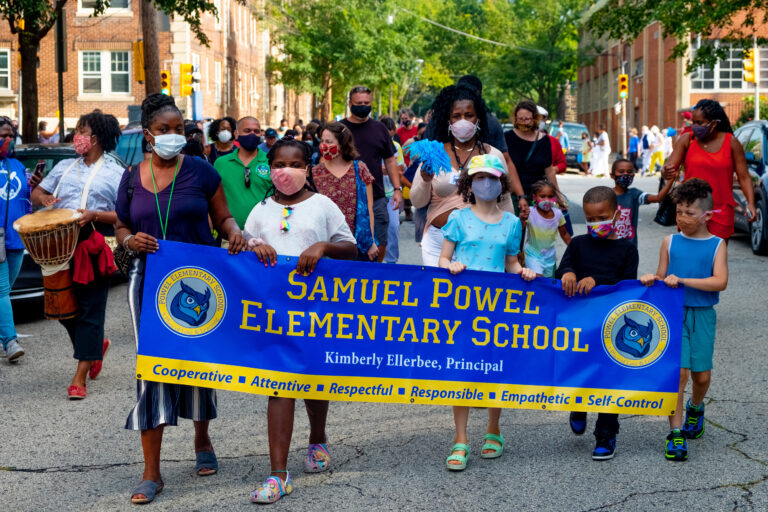Photos by Jeff Fusco
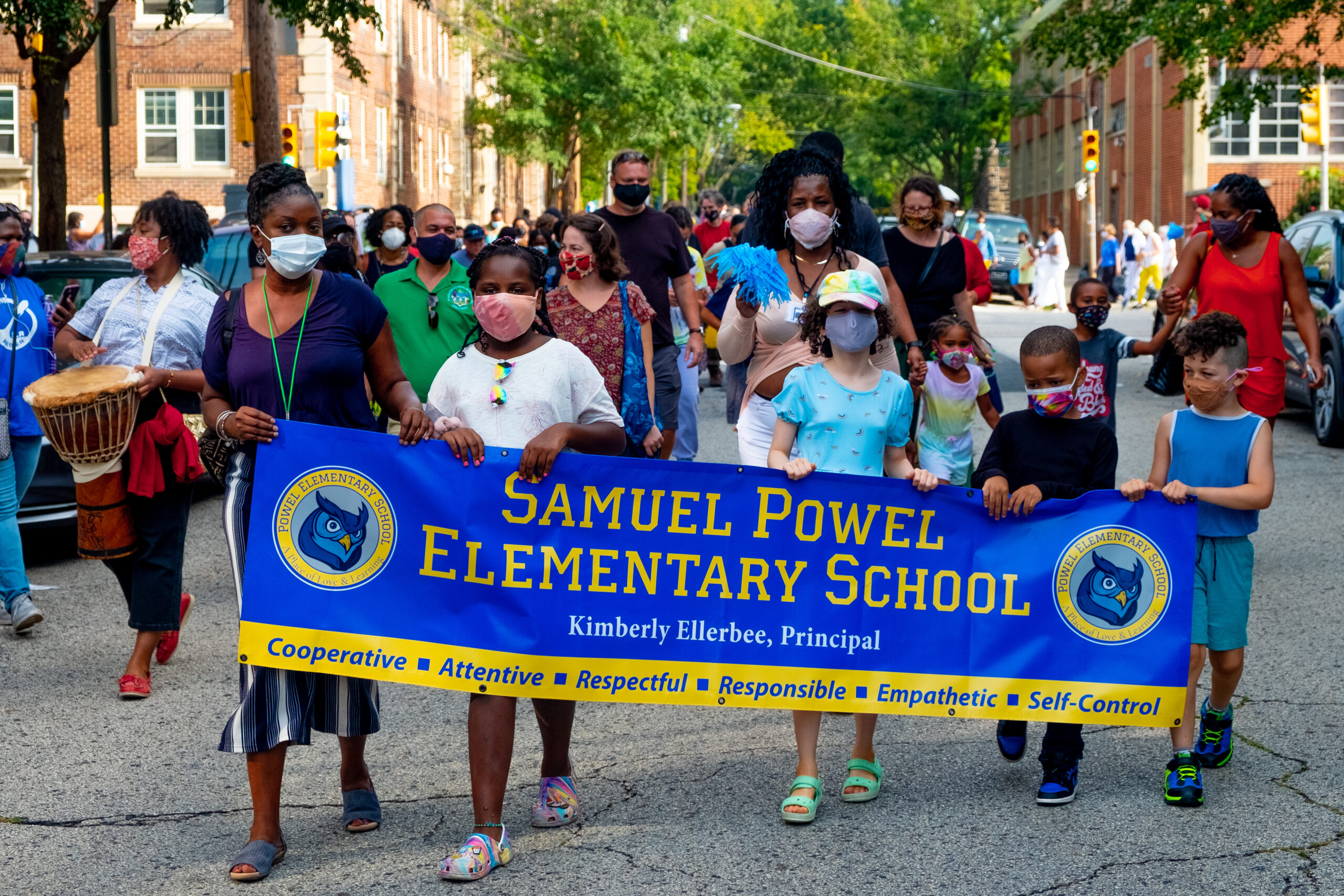
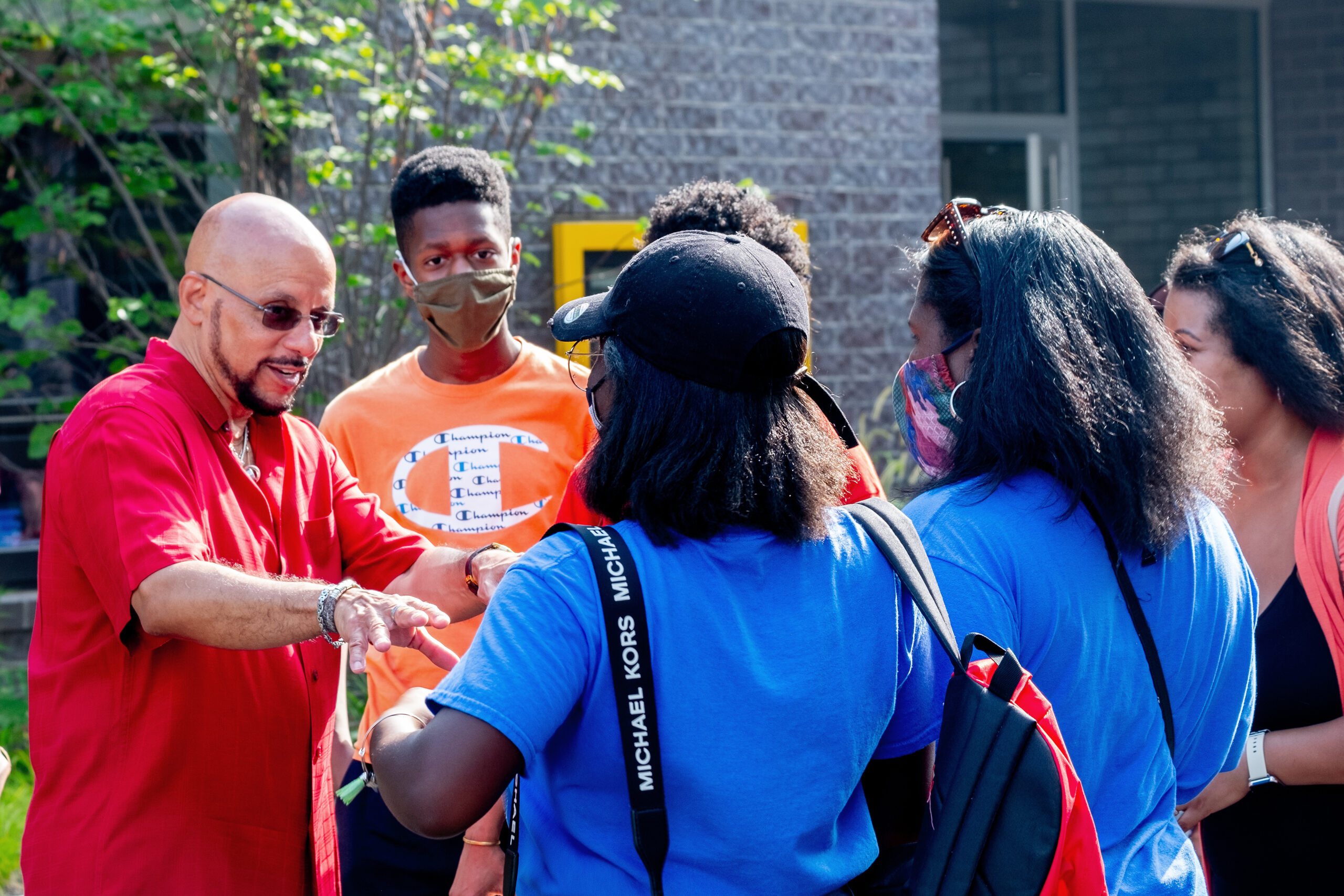
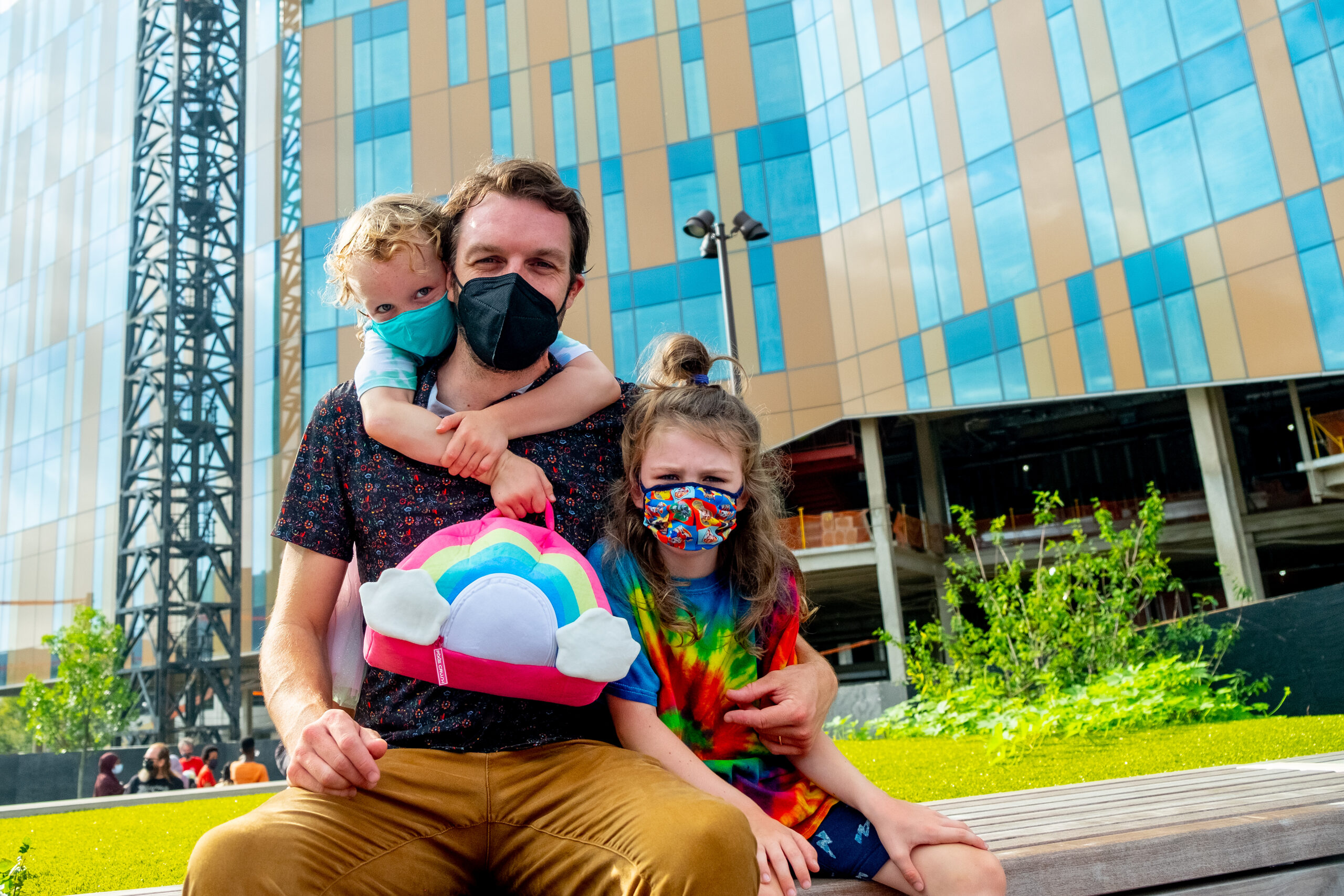

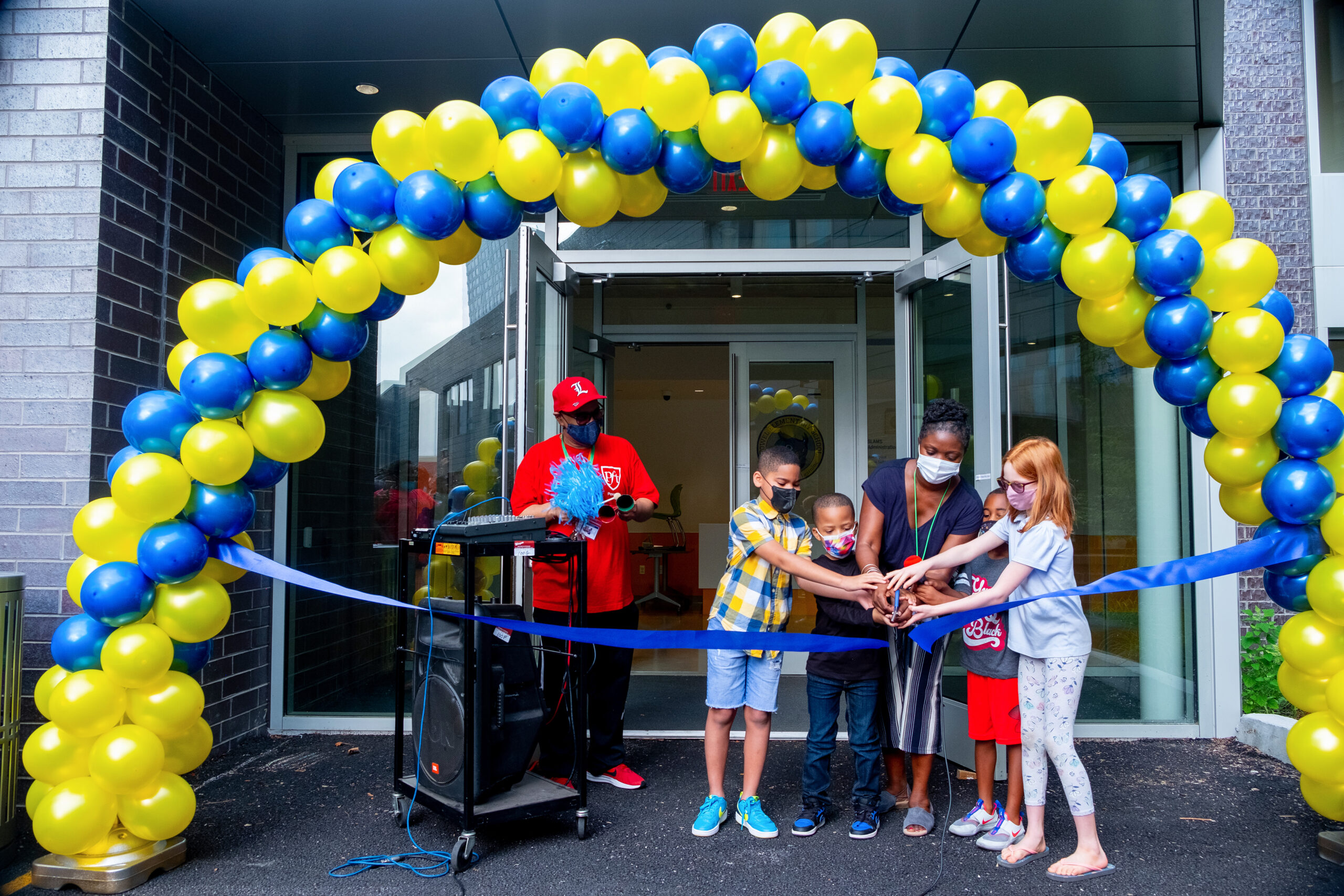
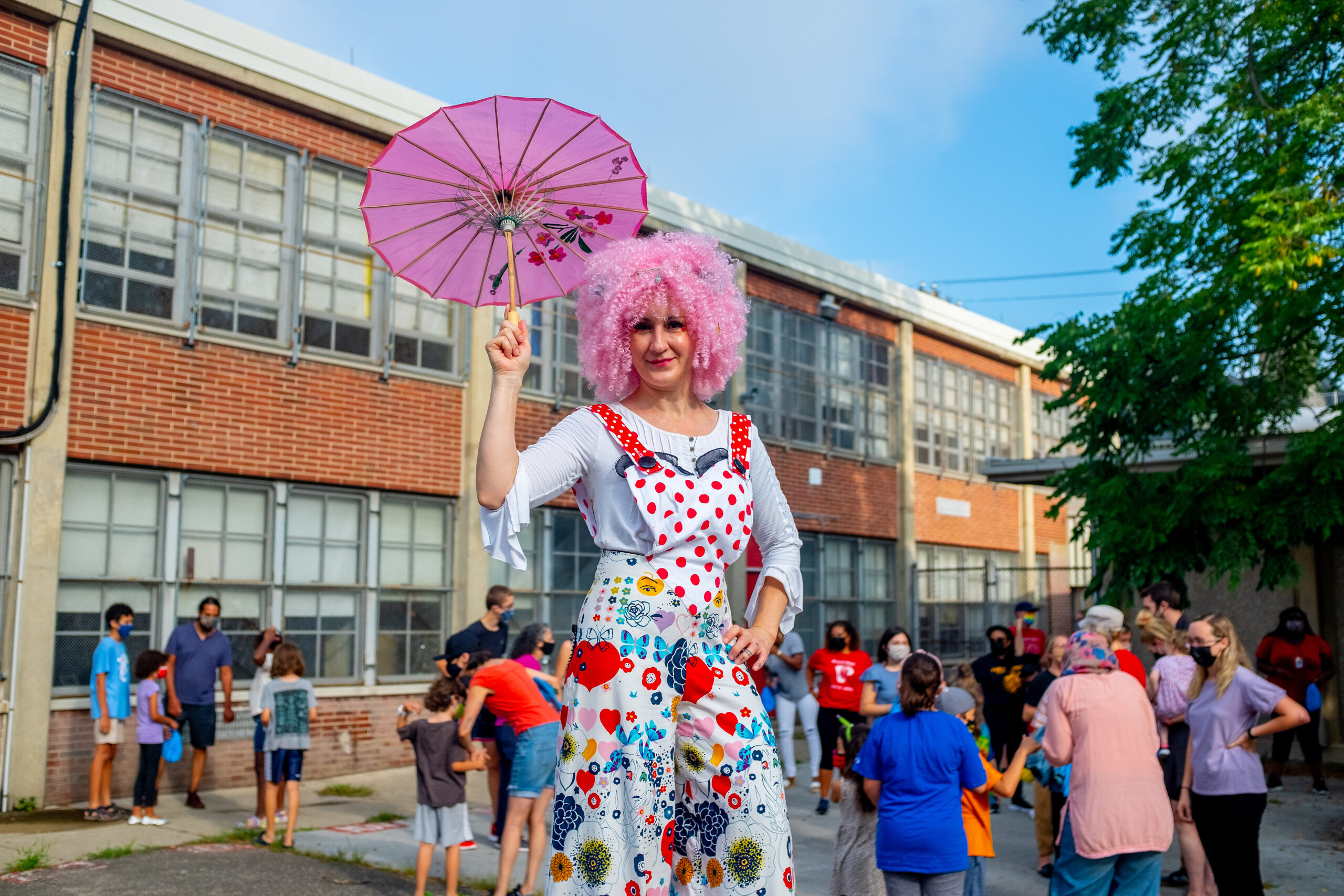
Among those celebrating the new school in late August were state Sen. Vincent Hughes and Powel parent Jamie Grimble, with his young Powel Owls. Credit Jeff Fusco.
They trickled into the courtyard of the old Samuel Powel Elementary School on the corner of Powelton Avenue and North 36th Street on a sunny August morning, the eve of the first day of the new school year. Parents and students, grandmothers with babies in strollers, current and former teachers and staff — more than 100 in all — came to bid a farewell to their beloved neighborhood school and take a symbolic walk to their new home.
As a stilt dancer tottered through the throng and African drums set a festive beat, Principal Kim Ellerbee rounded up the crowd behind a Powel banner and began to lead a procession two blocks south to the new Powel, in Drexel’s ambitious uCity Square development.
The walk finished at the doorstep of a $40 million, 87,000-square-foot showcase that also houses the Science Leadership Academy Middle School, or SLA-MS, in a unique shared building arrangement between an historic K-4 school and a relatively new 5–8 school.
“Today we begin a new phase in our history,” said Ellerbee as she invited children to help her cut the ribbon at the building’s entrance. “We celebrate all that Powel was, is and continues to be: a place of love and learning.”
That milestone caps a complex effort to establish a public school — a realization of President John Fry’s long-held vision that Drexel be not only an anchor institution in West Philadelphia, but a foundation for community advancement.
In that, President Fry has followed a style of purposeful development he set first while executive vice president of the University of Pennsylvania and later as president of Franklin and Marshall College in Lancaster, Pennsylvania. Soon after he arrived at Drexel in 2010, he hired former Penn colleague Lucy Kerman, who had helped to shape the public-private coalition that created the successful Penn-Alexander School in West Philadelphia.
“Supporting local education is a high priority,” says Kerman, who wears the hat of senior vice provost for university and community partnerships. “It’s in our mission and is an appropriate role for anchor institutions to play.”
But unlike Penn-Alexander, which was a wholly new K-8 school, Drexel has sought to support existing community assets. And Powel, known as a bright but vulnerable gem among the city’s schools, needed people in its corner.
Even before she arrived on campus, Kerman was receiving emails from the Powel Home and School Association asking the University for support, she says. Initially, Drexel assisted Powel and other neighborhood schools through a five-year program backed by a $1 million grant from the local gas and electric utility PECO, which funded the school library, teacher development and STEM programs, as well as similar programs at nearby Morton McMichael School.
But subsequent events opened up bigger possibilities. In late 2012, the financially strapped School District of Philadelphia proposed closing underutilized schools and consolidating smaller K–4 schools — a shift that parents worried would put Powel at risk.
“The most important thing was to preserve Powel school,” recalls James Wright, a SLA-MS parent. Wright is director of community, economic and real estate development for local nonprofit People’s Emergency Center, which is one of more than a half dozen community volunteer groups monitoring the development of uCity Square. Through his dual roles as parent and nonprofit leader, Wright was active both in the planning of the new school building and in rallying community stakeholders for input into the larger uCity Square development.
“[Powel] was too small and the new school model was K–8,” he explains. “We did not want a charter school. We wanted a school open to the community.”
At around that time, Kerman was also talking to Chris Lehmann, the founding principal of Science Leadership Academy High School, about partnering with Drexel on a new middle school for the neighborhood. Science Leadership Academy’s hands-on experiential learning model pairs well with Drexel’s, they agreed.
A community planning grant from the Philadelphia School Partnership allowed Drexel to frame out an early vision for two schools, intimately connected, to provide a seamless elementary through middle school environment.
Then a crucial opportunity arrived in 2013, when the district resolved to close both Drew Elementary School (like Powel, an endangered neighborhood school) and University City High School, which shared a 14-acre site in University City adjacent to Drexel’s footprint — and to sell the parcel.
The opportunity launched a year-long process led by Drexel’s Office of Government and Community Relations to secure city zoning approval to develop the site, as a condition of Drexel purchasing the site with its development partner, Wexford Science & Technology of Baltimore.
Success depended on working constructively with seven registered community organizations, People’s Emergency Center and the Powelton Village Civic Association among them, who wanted a voice in the development. Later, through the establishment of a Community Advisory Group, leaders from those groups joined representatives from City Council to oversee the development of the site, which is still ongoing.
“These are people in the community who volunteer their time and give up evenings to have a say in design, use, traffic, pedestrian safety — all the things that a community would care about,” says Brian Keech, senior vice president of government and community relations, of the project’s registered community organizations.
Keech’s office also obtained $3 million from government sources to help reconstruct the original street grid around the school.
As part of the sale agreement, Drexel pledged to raise funds to pay for construction of a new public school on the parcel, with the school district leasing back the property for a nominal fee. President Fry described it as a public-private partnership at its “finest and most creative.”
Raising funds for the school took six years, but Drexel eventually patched together a quiltwork of support from the Lenfest Foundation, PECO, real estate investment trust Ventas, as well as New Market Tax Credits, the School District of Philadelphia, and funds from a state Redevelopment Assistance Capital Program grant which was secured through the efforts of state Sen. Vincent Hughes, Gov. Tom Wolf and others.
Kerman hopes the “coalition of funders” model inspires other universities and school districts in need of new facilities who are unable to foot the bill themselves.
“Piecing together multiple sources of private and public-private dollars may in fact solve some of the construction challenges that public school systems are facing, not only in Philadelphia, but nationally,” says Kerman.
Meanwhile, as fundraising was underway for the school building, the Science Leadership Academy Middle School opened in 2016 with grade 5 in temporary quarters at Drexel’s Dornsife Center for Neighborhood Partnerships. After its first two years with grades 5 and 6, it moved to larger leased space at the University City Science Center to fully expand to grades 7 and 8. Though no one could have predicted as much when the School District of Philadelphia first put its land in University City up for sale, SLA-MS reached its mature capacity the same year its permanent home finished construction.
Throughout the development of the uCity Square parcel, Drexel placed the onus on itself to develop the school building thoughtfully, with community input, engaging many of the same community stakeholders who were involved in oversight of how the larger uCity Square parcel would be constructed and developed.
Wright of the People’s Emergency Center says that as soon as the closure of the high school was a done deal, PEC sprang into action, rallying community members to participate in the planning and design of the new building and staying involved in the community benefit response.
“There was great community involvement,” says Wright, speaking as a current SLA-MS parent. His son Samuel is a 7th grader at SLA-MS and his older son, Emmanuel, a 2021 SLA-MS graduate, is now attending George Washington Carver High School of Engineering and Science.
Enter architect Rob Rogers, principal and founding partner of Rogers Partners Architects + Urban Designers, whose New York-based firm has a national reputation for designing award-winning public buildings.
Rogers was drawn to the project because of the integration of the school into the uCity Square innovation district.
“We were super excited because most innovation districts are focused only on higher ed and economic and intellectual overlaps at that level,” says Rogers. “This was the opportunity to engage a community in that exercise and we found that incredibly compelling.”
Rogers’ firm is acclaimed for its design of Henderson-Hopkins School, a new Baltimore school built in partnership with Johns Hopkins University. He says completing the project involved navigating the complexity of “multi-headed clients” and the challenge of budget and schedule. The goal, he says, like Powel/SLA-MS, was seeing buildings “as consequential participants in communities, neighborhoods and cities.”
“Your constituents really are the children and teachers who are going to occupy the building, but there are all the structures above — financing, building organization, property ownership — and all the pieces bring major players together to make a project,” Rogers says. “Sometimes the best projects actually come out of complex situations, because rote solutions are not available.”
As the firm examined a multitude of site issues in University City — from soil conditions and a stream running under the property, to pedestrian access and determining how the school would relate to as-yet-unbuilt buildings — the architects listened to community voices wanting to know how the schools could serve neighborhood needs and how the site design could be responsive to the existing architectural fabric.
Elizabeth Stoel, the firm’s project director, described the design response as “context-sensitive massing,” achieved by limiting the height of the U-shaped building to two stories to match the stature of the historic Warren Street residential block. The site design also restores the historic street grid, notably 37th Street and Cuthbert Street, which had been removed to make way for the University City High School, and it creates a pedestrian-only street linking the school building with the University’s buildings.
By locating the administrative offices and classrooms on the north side facing Warren Street while placing the gym and cafetorium on the south side facing the courtyard and playground, the design respects the community’s desire for less traffic and noise on the residential side. The gym and cafetorium serve as the building’s bookends and public spaces that, when lit at night, resemble garden lanterns.
The architects considered both how the schools would work together and what spaces needed to be separate. Powel students occupy the first floor, which contains more traditional classrooms flooded with light from the large windows. SLA-MS students occupy the second floor, where hallways were widened to accommodate informal group workspace. Science labs and maker space for SLA-MS’s experiential curriculum round out the building.
Vital to the Powel mission, Kerman says, was maintaining its independence and valued routines. Separate entrances for each school, for instance, accommodated Powel’s traditional morning line-up while giving SLA-MS students space for freeform comings and goings.
Improving health and safety was also important in a city where many public school buildings contend with lead and asbestos abatement issues.
Jamie Grimble, second vice president of the Powel Home and School Association, said that while no one could have anticipated a pandemic, the building’s modern ventilation systems and open spaces naturally allow for better air flow and social distancing.
“We are so fortunate,” says Grimble, whose two sons Fletcher and Finnegan attend Powel.
The Powel/SLA-MS project recently received kudos from Urban Land Institute Philadelphia for excellence in public-private partnerships, education, development and community engagement.
“Jurors were impressed with this particular project’s complicated funding structure, high stakeholder involvement, thoughtful design and community engagement strategies,” says executive director Laura Slutsky, adding that URI plans to promote the public-private partnership as one that could be replicated in other communities.
The School District of Philadelphia praised Drexel for making “a significant investment” that will be a source of pride for educators, students and families.
“We hope that this partnership model, where a community partner worked to address the needs of nearby schools and demonstrated a true commitment to equity and high-quality education in the neighborhoods they serve, can be a model for future schools,” the district said in a statement.
The Powel/SLA-MS building was merely the first newly constructed building within Wexford’s uCity Square master plan. The lots surrounding Powel/SLA-MS are gradually transforming into a place for innovation that will attract bright minds and equip them to pursue new endeavors in the life sciences field.
“We’ve turned a once-closed, government-owned public school property generating no revenue into a tax- and job-generating powerhouse,” says Keech.
Adjacent to the school, Wexford is also building a high-rise to house Drexel’s College of Nursing and Health Professions and parts of the College of Medicine, on track for completion in 2022. Across the street, a new office tower geared toward emerging tech commercialization tenants called One uCity is a year away from opening, but is already 60 percent committed, according to Wexford. Wexford is also putting the finishing touches on Anova uCity, a residential high-rise for professionals drawn to the area’s institutions and amenities, with retail on the street level. The new buildings complement the existing University City Science Center and Drexel’s incubator ic@3401 along Market Street.
Kerman envisions relationships springing up in myriad ways through these entities. For instance, the nursing school might organize a nutrition or wellness programs for the Powel/SLA-MS students, she says.
“Some magic will happen,” Kerman predicts.
On a longer horizon, she foresees the innovation district sparking serendipitous career paths for the students who learn here. She calls it a “cradle-to-career ecosystem” that can unlock enormous potential for young people and their families.
“We want to introduce parents to the possibility of job opportunities that surround them,” she says. “The idea that schools are isolated…they’re not; they’re urban and very dynamic.”
Students had a sampling of life in the new school last spring when in-person learning briefly resumed. Wright says his son Emmanuel was drawn to the texture of the building. He wants to be an architect, Wright says, in part because he’s been inspired by growing up in a neighborhood where construction cranes have been a constant on the horizon.
“I love the building; it embodies what the teachers thought was important,” Wright says. “It’s a godsend, and I was not a believer.”
Wright admits he never thought the idea would come to fruition. “It was too a high a hurdle,” he says. “But they did it, and I am grateful.”
Among those on hand for the August processional and ribbon cutting was state Sen. Hughes, who represents a large swath of West Philadelphia and helped secure state funding for the school construction.
“This is the kind of school that every child in Philadelphia should have,” he said, as he mingled with parents and teachers.
He paused to take in the view of Drexel’s health sciences tower rising against the sky a few yards from the Powel playground. “The message is, when you leave here, you’re going to be there one day, saving the world,” he said.
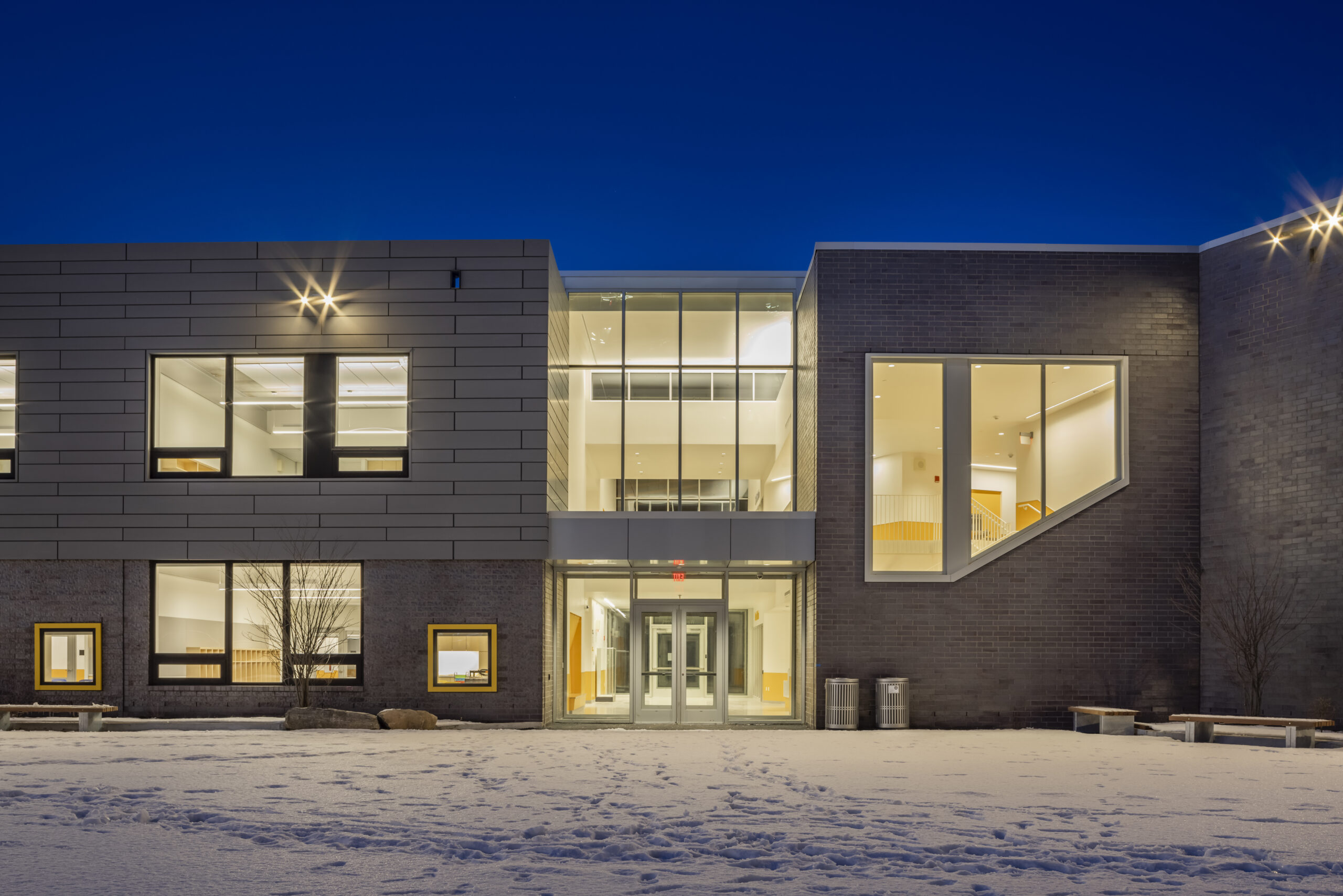
Albert Vercerka/Esto
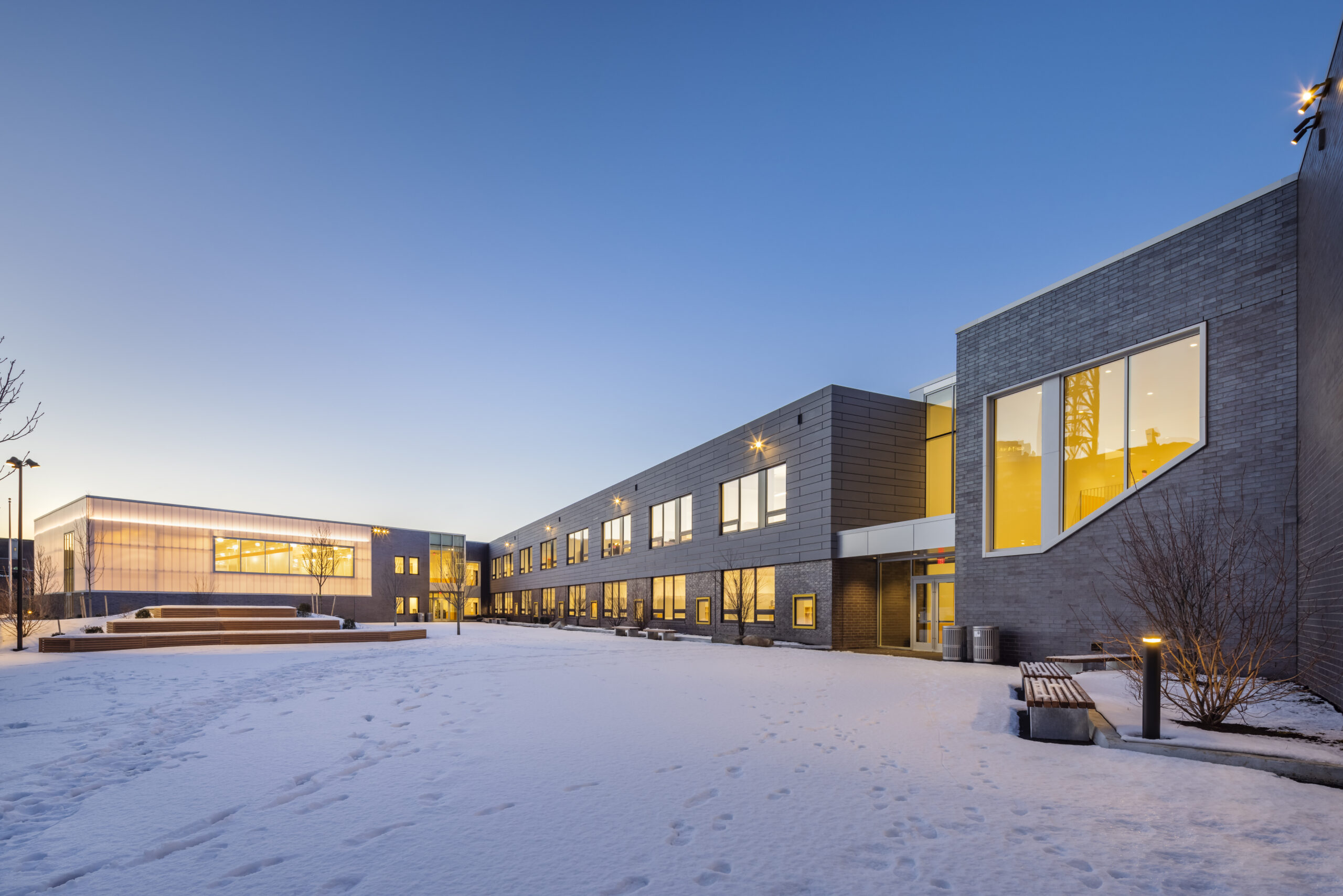
Albert Vercerka/Esto
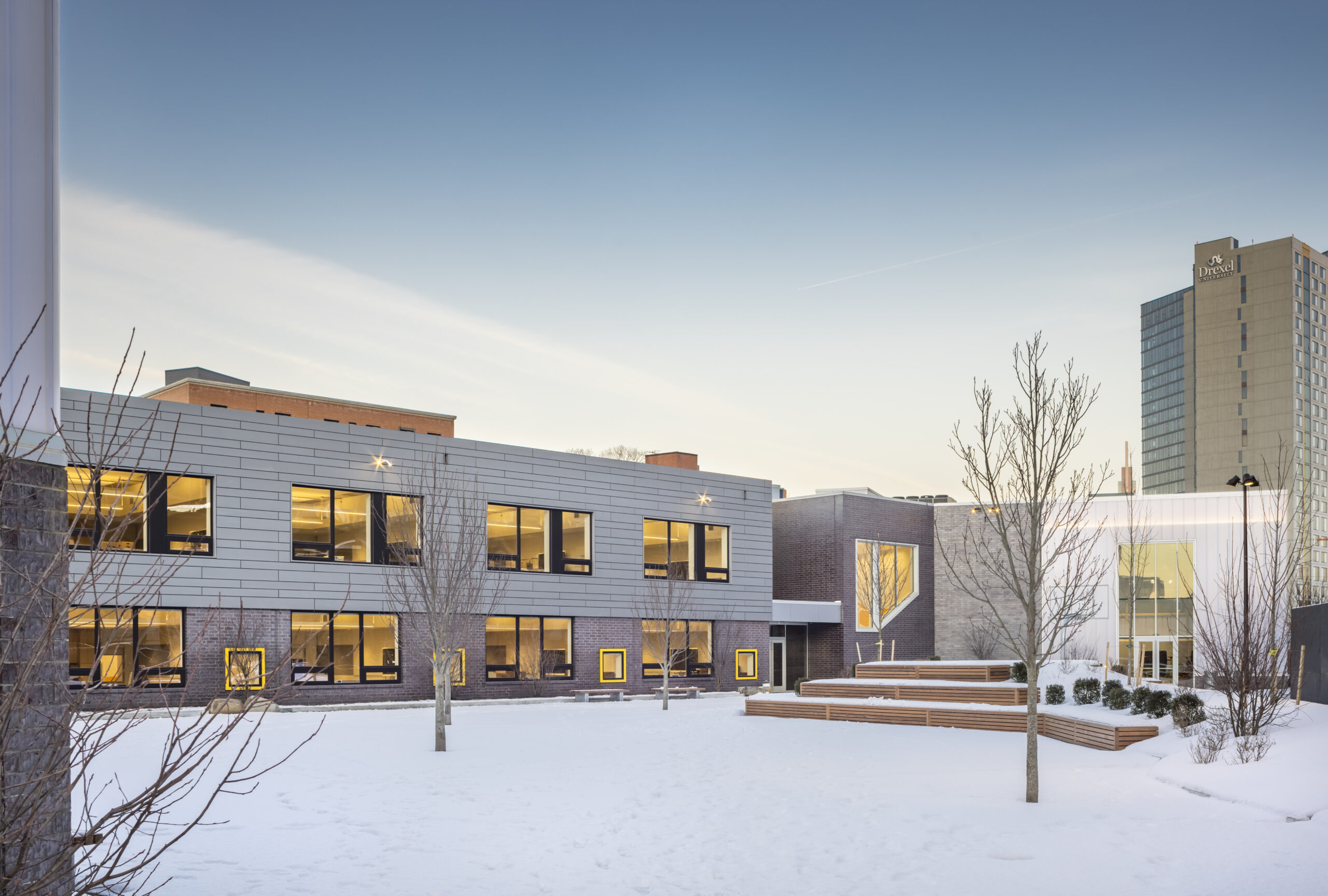
Albert Vercerka/Esto

Albert Vercerka/Esto

Albert Vercerka/Esto
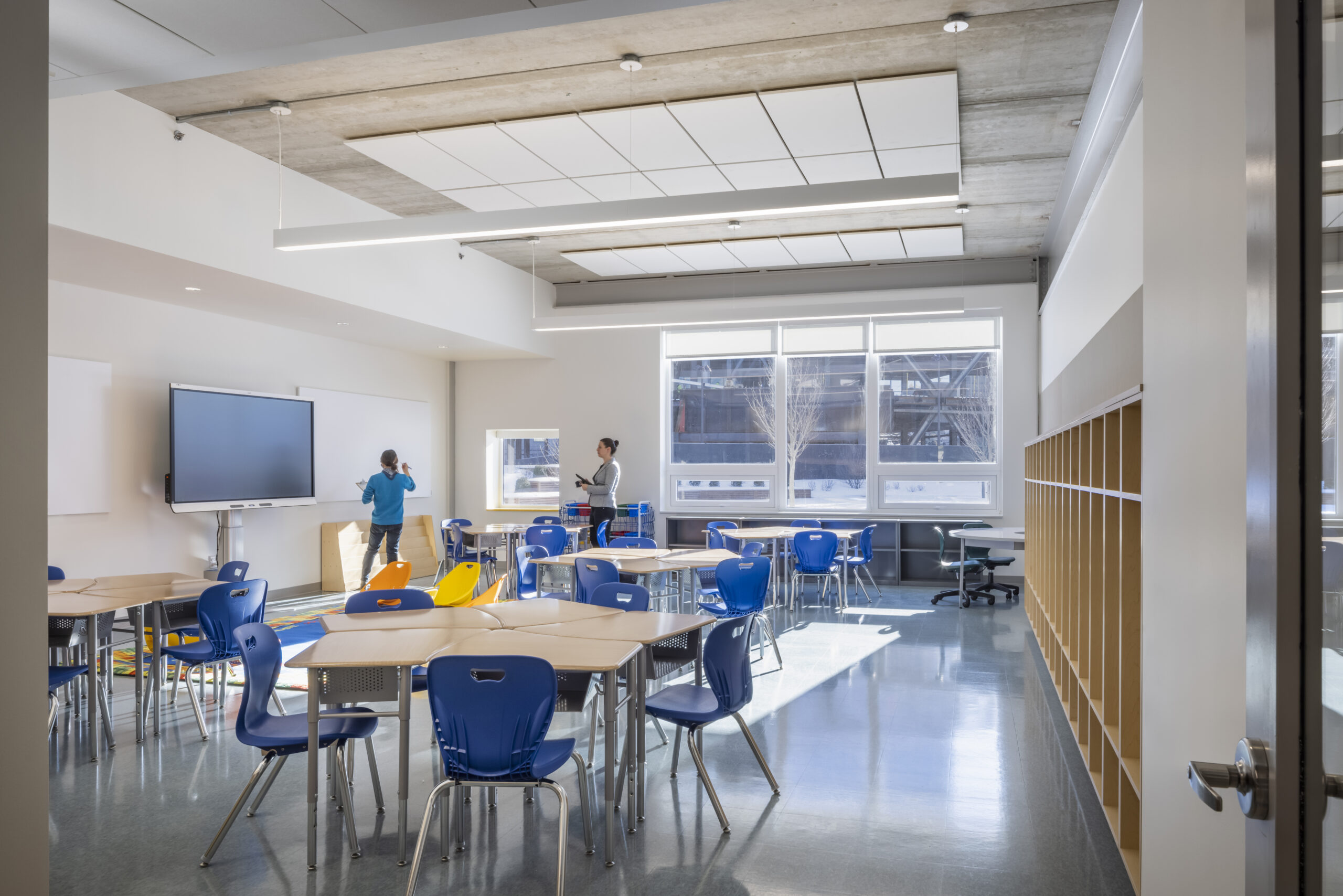
Albert Vercerka/Esto
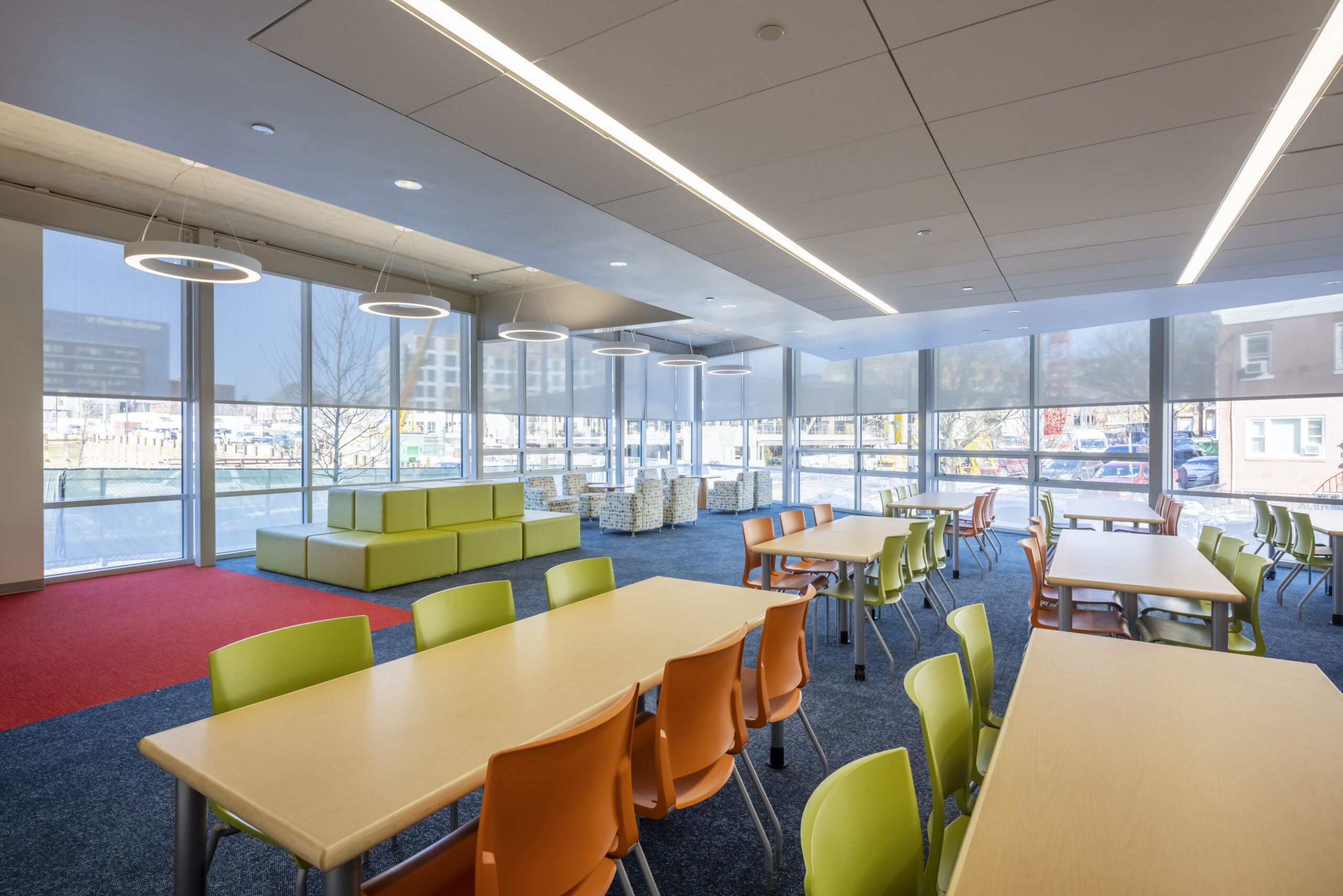
Albert Vercerka/Esto
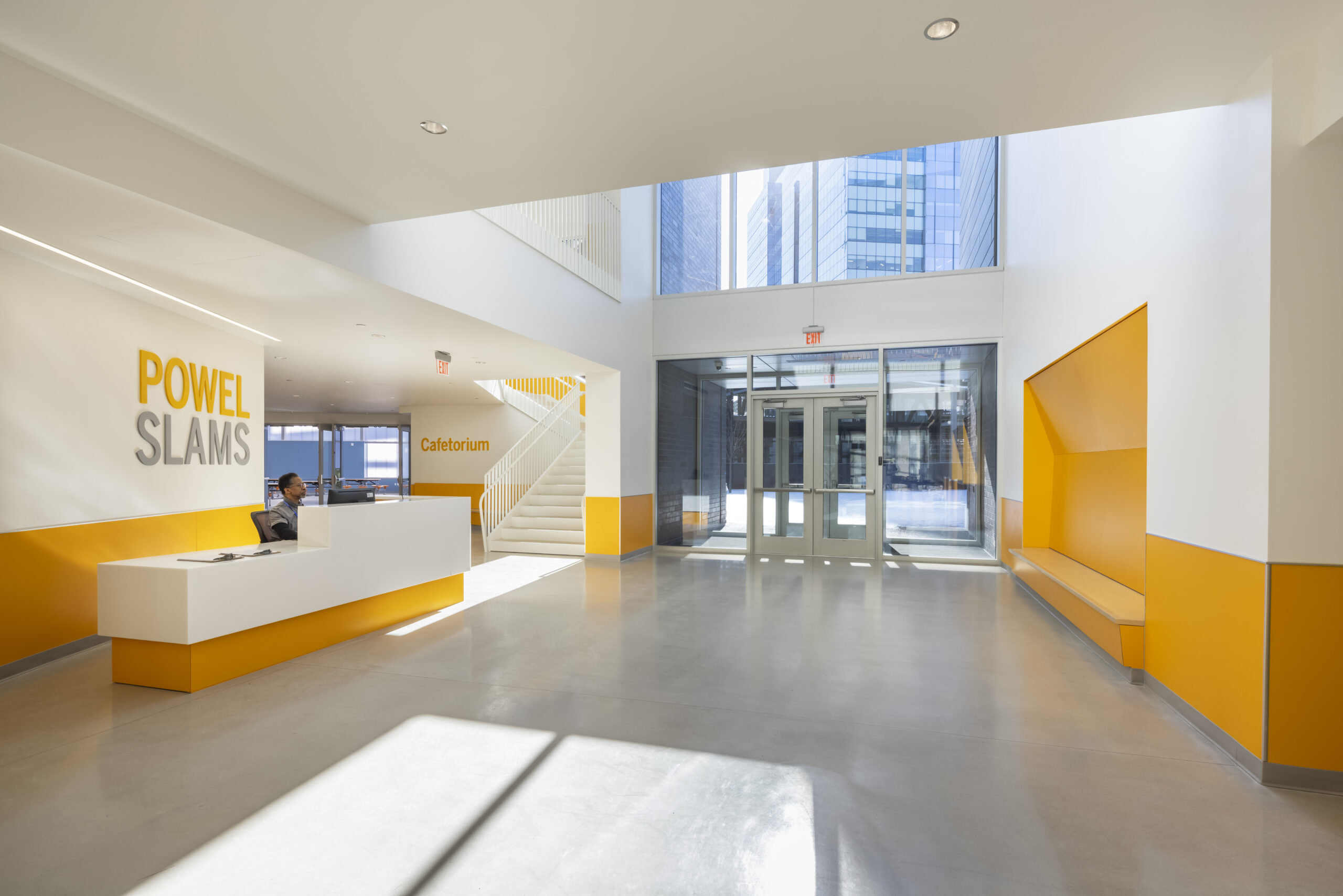
Albert Vercerka/Esto


